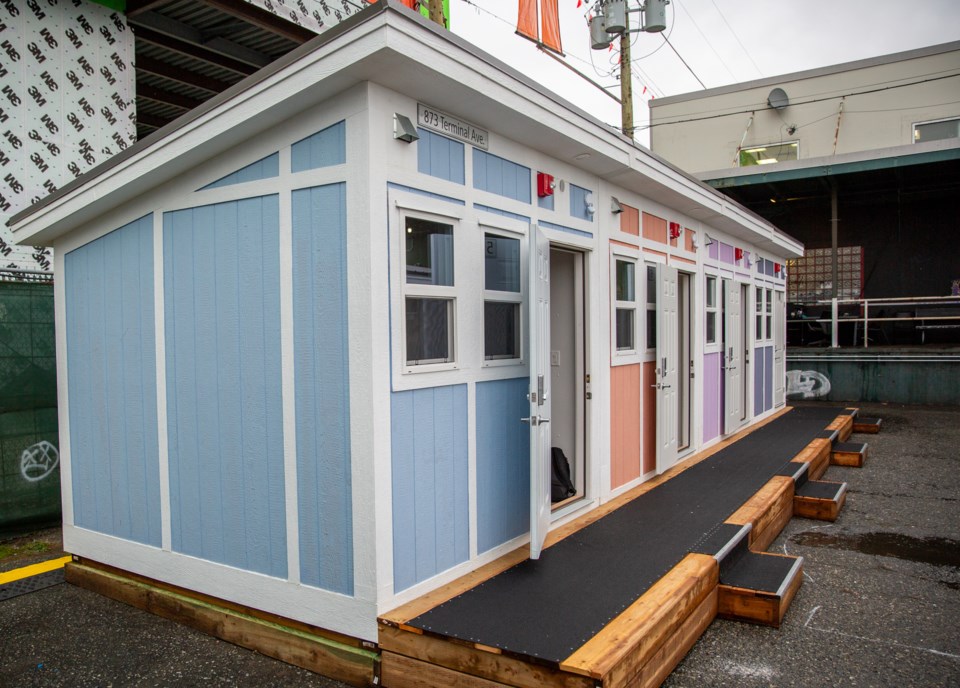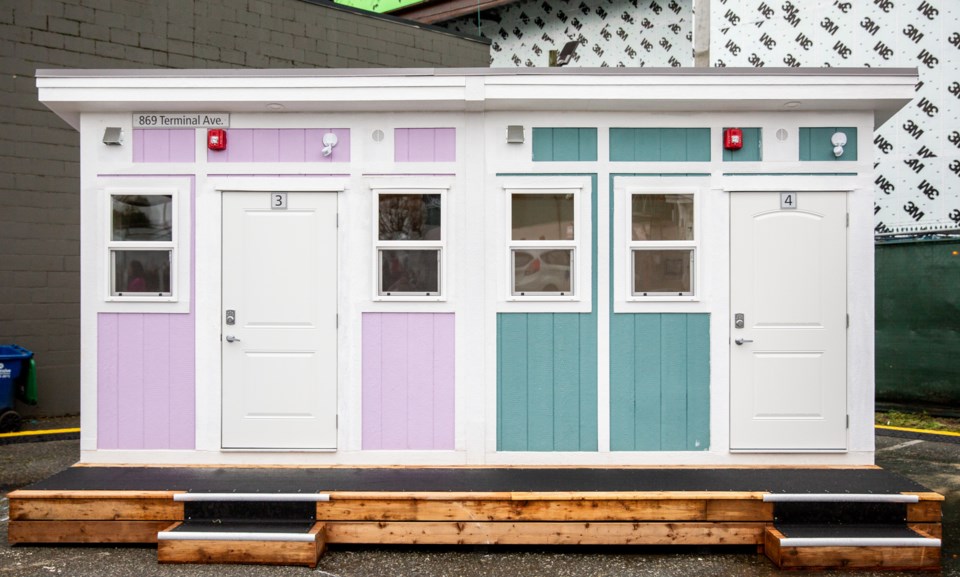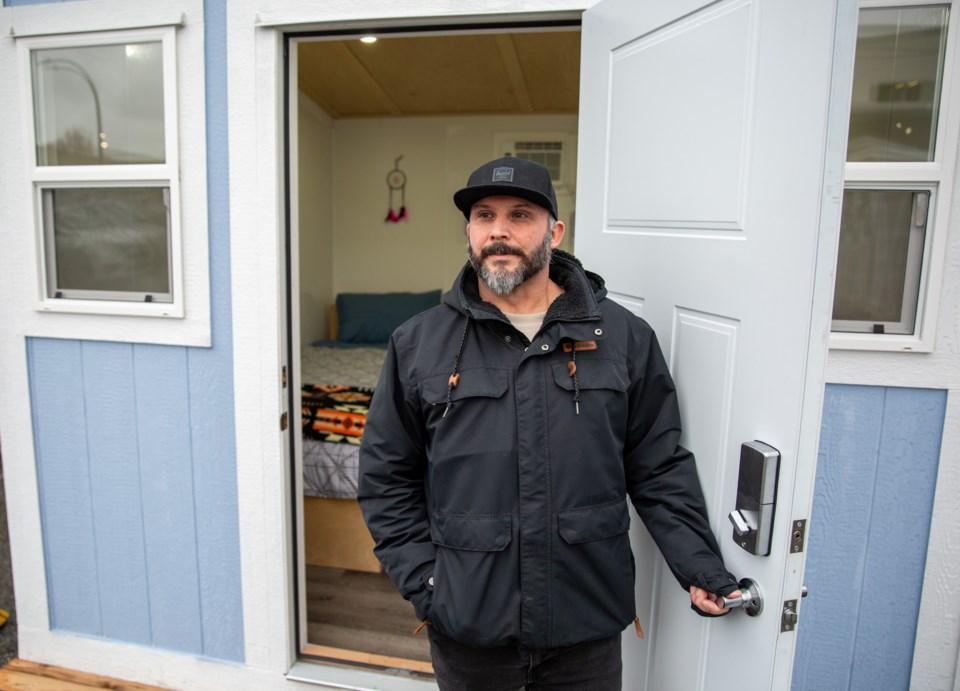Vancouver’s two-year experiment with “tiny shelters” begins next week when up to 20 people will move into newly constructed cabin-like structures set up in the parking lot of an existing shelter near Clark Drive and Terminal Avenue.
Kevin Eaton, executive director of supportive housing for Lu’ma Native Housing Society, said there is no shortage of homeless people wanting to be the first to move into the 10 100-square-foot units.
“There's tons of need,” said Eaton during a tour Wednesday of the shelters. “Lu’ma and the City of Vancouver and Carnegie [outreach team] are working together in efforts of determining those who will stay here. There's a list of folks already wanting to get in here.”
Spread over four small buildings, the 10 units — two of them designed for people who require mobility devices such as wheelchairs — are not being called homes because they are not outfitted with a bathroom or cooking facilities.
The new tenants will have access to those services, meals, laundry and 24-hour staff support in the neighbouring Klahowya Tillicum Lalum shelter at 875 Terminal Ave., which has operated for two years and offers 80 shelter beds.
Lu’ma operates the facility and will be responsible for managing the tiny shelters, which are fully insulated with heating-air conditioning units, lighting, windows and locking doors.
All units are equipped with fire extinguishers, smoke and heat detectors and have a direct link to the fire department. Emergency strobe lights are mounted outside the rooms and will activate if an alarm is triggered.
Couples — which could include a parent and adult child — are expected to be among most of the tenants, with the units offering a mix of double and single beds.
“The thinking was we're trying to really reach folks who have chosen not to use the congregate shelters for a variety of reasons related to their kind of household structure,” said Bruk Melles, the city’s director of homelessness services, who was at the site Wednesday.
Tenants can also have pets.

$26K each to build
The budget for the units was $500,000 and another $1 million goes to Lu’ma to cover operating costs over the two years of the experiment.
The city didn't immediately have a breakdown of the building costs, but builder Rob Calis of Pittfield Design Inc. and ZenDenz.ca said in an email that each unit cost $26,000, including furniture, air conditioning, heating, dehumidifier and fire safety systems.
"The other costs that have been applied to the project are site and infrastructure specific and would vary project to project," said Calis, noting the city had to supply power to the units and do additional work to connect fire safety systems.
An evaluation will be completed before a decision is made whether the units will become permanent.
The project was mired in delays, with Coun. Pete Fry expressing his frustration in a previous interview, pointing out the tiny shelters were supposed to be an urgent response to the city’s homelessness crisis.
Council voted in February 2022 to proceed with the shelters.
“The whole point of [these shelters] was they would be for rapid deployment — that was the whole idea,” Fry said in August.
City staff originally anticipated the shelters would open in September 2022. Then the opening date shifted to spring of 2023. Now, the date has moved to next week.
In that span of time, a homeless count conducted in March revealed Vancouver had a population of 2,420 people without a home, with 605 unsheltered; officials often point out after every count that the exercise is an undercount because volunteers only capture a snapshot of the crisis.
In addition to those statistics, the city-led action April 5 to on East Hastings Street displaced many people living in tents, which resulted in the Lu’ma shelter on Terminal Avenue having to expand by 30 beds at one point.
“In response to the growing need, we said ‘Yes, we will do this, and we will make it work for as long as needed,’” said Eaton, noting the shelter now operates at 80 beds, 10 fewer than a few months ago.

Indigenous homeless
The homeless revealed once again that Indigenous peoples are overrepresented, with 39 per cent of survey respondents identifying as Indigenous; almost half of people counted as unsheltered were Indigenous.
The Metro Vancouver Indigenous population is estimated at 2.3 per cent.
Eaton, who is Nuu-chah-nulth from the Ahousaht First Nation, acknowledged the overrepresentation of Indigenous peoples on the streets, but said the existing shelter and tiny shelters are open to all in need.
He said the hope is that the new tenants will use the shelters as a conduit to access health services, housing, get connected or reconnected with community and culture and work with staff on their needs.
“And creating that base comfort, that base level of trust, where folks are willing to open up and start wanting to work with individuals in those specific areas,” Eaton said.
City staff present at Wednesday’s tour emphasized that shelters are not the solution to end homelessness, although temporary winter shelters, warming centres and other spaces are all needed at this time.
“These are 10 buildings,” said Celine Mauboles, the city’s managing director of housing and homelessness services.
“We've created over 330 spaces for this winter. Do we need more? Yes. Is shelter the solution? No, we need housing. So we're trying to hit right across the continuum to support [people in need].”
Note: This story has been updated to provide a more detailed breakdown of the costs to build each of the tiny shelter units.


